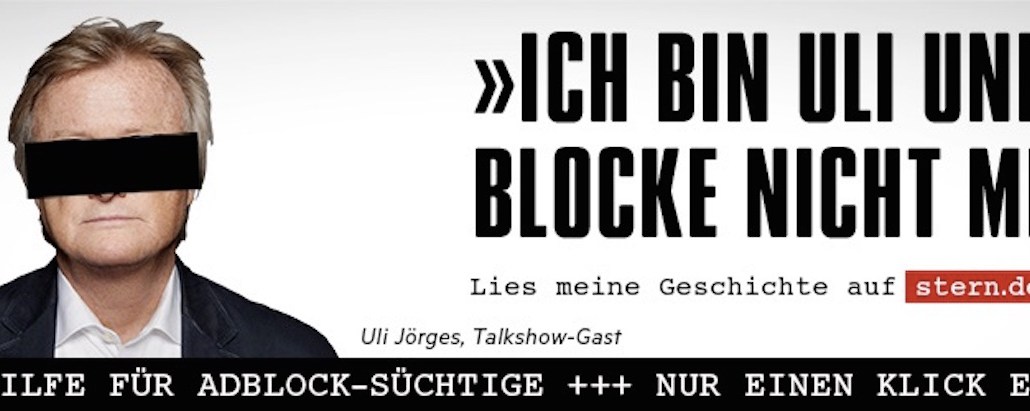German publisher Gruner + Jahr’s latest ad blocking tactic: Humor

German publishing giant Gruner + Jahr has one of the more sophisticated ad blocking strategies in the market.
When it first took action last November, it followed in Axel Springer’s footsteps with a hard ban on ad blocker users accessing its special-interest magazine sites. But it held back on running a hard ban across its main news brand Stern. That’s because it’s tougher to ban ad blocker users on general news sites — people just go elsewhere. For niche publications with differentiated content, it’s an easier sell. So, instead, it’s gone for a humorous approach on Stern. And it seems to be working.
Digiday caught up with G+J’s managing director of digital Oliver von Wersch, who is also chairman of the Online Marketers Association. Von Wersch spoke about what G+J has learned from its ad blocking tests, and what the global ad blocking coalition, announced last week, will look like.
Here are the takeaways:
Make ’em laugh
Four weeks ago G+J put months of tests on its other sites, into action on Stern. Although tests across seven of its special interest sites, including Geo.de (equivalent of National Geographic) and interior design site Schoenerwohnen.de, have caused ad blocking rates to drop up to 50 percent, it knew a replica approach would’t work on Stern.
Instead it’s gone for humor, with a smattering of ad blocker pop-up messages placed strategically throughout the site.
Stern has parodied a current anti-drugs ad campaign in Germany, with one of its own. A banner now runs across the top of the home page, for anyone who visits with an ad blocker switched on. The ad rotates to feature one of three recognisable figures: two of which are Stern’s editor-in-chiefs Christian Krug and Uli Jörges, who are well-respected journalists, and the third a famous German blogger. Next to their pictures it reads: “Ich war heavy blocker jetzt geht’s mir gut” which translates to “I was a heavy blocker, but now I’m not and I’m OK.”
Underneath the banner which also features the editor with a black rectangle covering their eyes, it reads: “First Aid for ad blocker addicts” (Erste hilfe für adblock süchtige) in German and has a fake help-line number. Clicking through gets readers to blog posts written by the editors as if they’re recovering addicts — of ad blocking.

“The user can ignore it and surf on with an activated ad blocker, but many have decided to turn their blocker off because they like the campaign,” said Von Wersch. Since using this approach ad blocking rates on Stern have dropped 22 percent.
When not to block ad blockers
A key lesson from tests on its special interest sites was that ad blocker pop-up messages asking people to switch off their blockers or ask for a micropayment, works best when used sparingly. “You don’t need to run these messages across every page of your site. We don’t want to bombard people,” said Von Wersch. “We just want to inform them of our business model. We don’t run them on pages where there’s access to our online shops like on Schoenerwohnen.de for example, or where we have a lot of social content links because it wouldn’t make sense.”
Stern ad blocker messages are currently running prevent people clicking through, but only on a carefully selected pages, like its most exclusive interviews or any content which isn’t easily obtainable elsewhere, and which has taken significant journalistic resource.
“Our users accept that we’re ad financed so as soon as we started a dialogue with them, no matter what exact solution had been implemented, they understood our motives and gave stimulating feedback saying they understood, with some pointing out where the ad experience could be better, he said.
The ad blocking coalition will not be a regulator
The coalition’s first step will be to gather all the user research companies like Google, Facebook, publishers, IAB Tech have done into why people are blocking ads, and drill into the details of what bothers them. “We won’t be starting from zero because companies like Google The Washington Post, Gruner + Jahr, and IAB Tech have already carried out research. But that will inform the standards,” he added.
The rough plan is to have standards hammered out by early next year, but it’ll be tough to put a date on the exact time due to the amount of work that must be done. In terms of the end goal, Von Wersch stressed that the coalition will not have the power of a regulator to actually police ads, but having such major players from all sides of the advertising ecosystem, will make it pretty hard for anyone not in the coalition to break ranks.
Oliver von Wersch will elaborate on the progress made by the “Coalition for better ads” at Digiday’s Publishing Summit Europe in Nice in October.
More in Media

Meta AI rolls out several enhancements across apps and websites with its newest Llama 3
Meta AI, which first debuted in September, also got a number of updates including ways to search for real-time information through integrations with Google and Bing.

Walmart rolls out a self-serve, supplier-driven insights connector
The retail giant paired its insights unit Luminate with Walmart Connect to help suppliers optimize for customer consumption, just in time for the holidays, explained the company’s CRO Seth Dallaire.

Research Briefing: BuzzFeed pivots business to AI media and tech as publishers increase use of AI
In this week’s Digiday+ Research Briefing, we examine BuzzFeed’s plans to pivot the business to an AI-driven tech and media company, how marketers’ use of X and ad spending has dropped dramatically, and how agency executives are fed up with Meta’s ad platform bugs and overcharges, as seen in recent data from Digiday+ Research.





